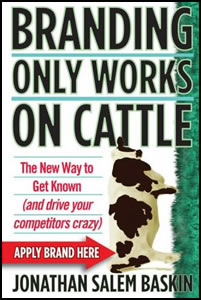
In Jonathan Salem Baskin’s book, Branding Only Works On Cattle, he takes firm aim at the practice of the marketing practice of branding. He defines branding as building consumer awareness with the goal of influencing their future behavior. Simply put, he believes that branding is useless.
Traditional marketing is focused on behavior: identifying prospective customers, their needs, and communicating how your business solves their problems. Behavior is measurable. Either someone takes action or they don’t. Split testing on messages can give statistically valuable information to improve your marketing campaign. You can optimize your marketing based on the response you do (or don’t) get.
Traditional branding is intangible. How can you measure the influence of someone’s future behavior? When it comes time to make a purchase decision, people don’t decide in a vacuum. They ask their community for input, do research, and then purchase. Impulse purchases aren’t made based on brand either; impulse happens on the spur-of-the-moment, and is based on the offering targeting the immediate need at the right price.
In the past, branding was possible because customers had few choices (besides their immediate community) – television (with just a few channels) and magazines. Larger corporations could spend money to control the messages of these limited media. The Internet has allowed people to easily search for information. Search, the author contends, is the enemy of brand. Search allows people to find information anywhere (not just in company-controlled locations). The end result is that companies are simply trying to scream louder to get their message heard about the din.
The author also believes that social online “communities” are a poor way to brand/market your company. Most of these communities aren’t really communities – people can be anonymous, there’s no shared responsibility, no trust, and no informal conversations.
Instead he suggests paying attention to the basic strategies of guerrilla marketing, which are focused on changing near-term behavior:
- Support existing behaviors, don’t create them [piggyback on habit]
- Show, don’t tell [by example]
- Prompt behaviors, not ideas [cause action]
- Talk to many, every time you talk [involvement by dialog]